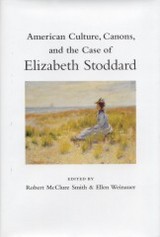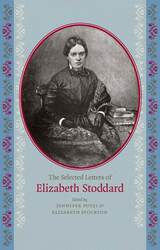2 books about Elizabeth Stoddard

American Culture, Canons, and the Case of Elizabeth Stoddard
Robert McClure Smith
University of Alabama Press, 2003
Reconsiders the centrality of a remarkable American writer of the ante- and postbellum periods
Elizabeth Stoddard was a gifted writer of fiction, poetry, and journalism; successfully published within her own lifetime; esteemed by such writers as William Dean Howells and Nathaniel Hawthorne; and situated at the epicenter of New York’s literary world. Nonetheless, she has been almost excluded from literary memory and importance. This book seeks to understand why. By reconsidering Stoddard’s life and work and her current marginal status in the evolving canon of American literary studies, it raises important questions about women’s writing in the 19th century and canon formation in the 20th century.
Essays in this study locate Stoddard in the context of her contemporaries, such as Dickinson and Hawthorne, while others situate her work in the context of major 19th-century cultural forces and issues, among them the Civil War and Reconstruction, race and ethnicity, anorexia and female invalidism, nationalism and localism, and incest. One essay examines the development of Stoddard’s work in the light of her biography, and others probe her stylistic and philosophic originality, the journalistic roots of her voice, and the elliptical themes of her short fiction. Stoddard’s lifelong project to articulate the nature and dynamics of woman’s subjectivity, her challenging treatment of female appetite and will, and her depiction of the complex and often ambivalent relationships that white middle-class women had to their domestic spaces are also thoughtfully considered.
The editors argue that the neglect of Elizabeth Stoddard’s contribution to American literature is a compelling example of the contingency of critical values and the instability of literary history. This study asks the question, “Will Stoddard endure?” Will she continue to drift into oblivion or will a new generation of readers and critics secure her tenuous legacy?
Elizabeth Stoddard was a gifted writer of fiction, poetry, and journalism; successfully published within her own lifetime; esteemed by such writers as William Dean Howells and Nathaniel Hawthorne; and situated at the epicenter of New York’s literary world. Nonetheless, she has been almost excluded from literary memory and importance. This book seeks to understand why. By reconsidering Stoddard’s life and work and her current marginal status in the evolving canon of American literary studies, it raises important questions about women’s writing in the 19th century and canon formation in the 20th century.
Essays in this study locate Stoddard in the context of her contemporaries, such as Dickinson and Hawthorne, while others situate her work in the context of major 19th-century cultural forces and issues, among them the Civil War and Reconstruction, race and ethnicity, anorexia and female invalidism, nationalism and localism, and incest. One essay examines the development of Stoddard’s work in the light of her biography, and others probe her stylistic and philosophic originality, the journalistic roots of her voice, and the elliptical themes of her short fiction. Stoddard’s lifelong project to articulate the nature and dynamics of woman’s subjectivity, her challenging treatment of female appetite and will, and her depiction of the complex and often ambivalent relationships that white middle-class women had to their domestic spaces are also thoughtfully considered.
The editors argue that the neglect of Elizabeth Stoddard’s contribution to American literature is a compelling example of the contingency of critical values and the instability of literary history. This study asks the question, “Will Stoddard endure?” Will she continue to drift into oblivion or will a new generation of readers and critics secure her tenuous legacy?
[more]

The Selected Letters of Elizabeth Stoddard
Jennifer Putzi
University of Iowa Press, 2012
In response to the resurgence of interest in American novelist, poet, short-story writer, and newspaper correspondent Elizabeth Stoddard (1823–1902), whose best-known work is The Morgesons (1862), Jennifer Putzi and Elizabeth Stockton spent years locating, reading, and sorting through more than 700 letters scattered across eighteen different archives, finally choosing eighty-four letters to annotate and include in this collection. By presenting complete, annotated transcripts, The Selected Letters provides a fascinating introduction to this compelling writer, while at the same time complicating earlier representations of her as either a literary handmaiden to her at-the-time more famous husband, the poet Richard Henry Stoddard, or worse, as the “Pythoness” whose difficult personality made her a fickle and unreasonable friend.
The Stoddards belonged to New York's vibrant, close-knit literary and artistic circles. Among their correspondents were both family members and friends including writers and editors such as Julia Caroline Ripley Dorr, Rufus Griswold, James Russell Lowell, Caroline Healey Dall, Julian Hawthorne, William Dean Howells, Helen Hunt Jackson, Edmund Clarence Stedman, and Margaret Sweat.
An innovative and unique writer, Stoddard eschewed the popular sentimentality of her time even while exploring the emotional territory of relations between the sexes. Her writing—in both her published fiction and her personal letters—is surprisingly modern and psychologically dense. The letters are highly readable, lively, and revealing, even to readers who know little of her literary output or her life.
As scholars of epistolarity have recently argued, letters provide more than just a biographical narrative; they also should be understood as aesthetic performances themselves. The correspondence provides a sense of Stoddard as someone who understood letter writing as a distinct and important literary genre, making this collection particularly well suited for new conceptualizations of the epistolary genre.
[more]
READERS
Browse our collection.
PUBLISHERS
See BiblioVault's publisher services.
STUDENT SERVICES
Files for college accessibility offices.
UChicago Accessibility Resources
home | accessibility | search | about | contact us
BiblioVault ® 2001 - 2024
The University of Chicago Press









